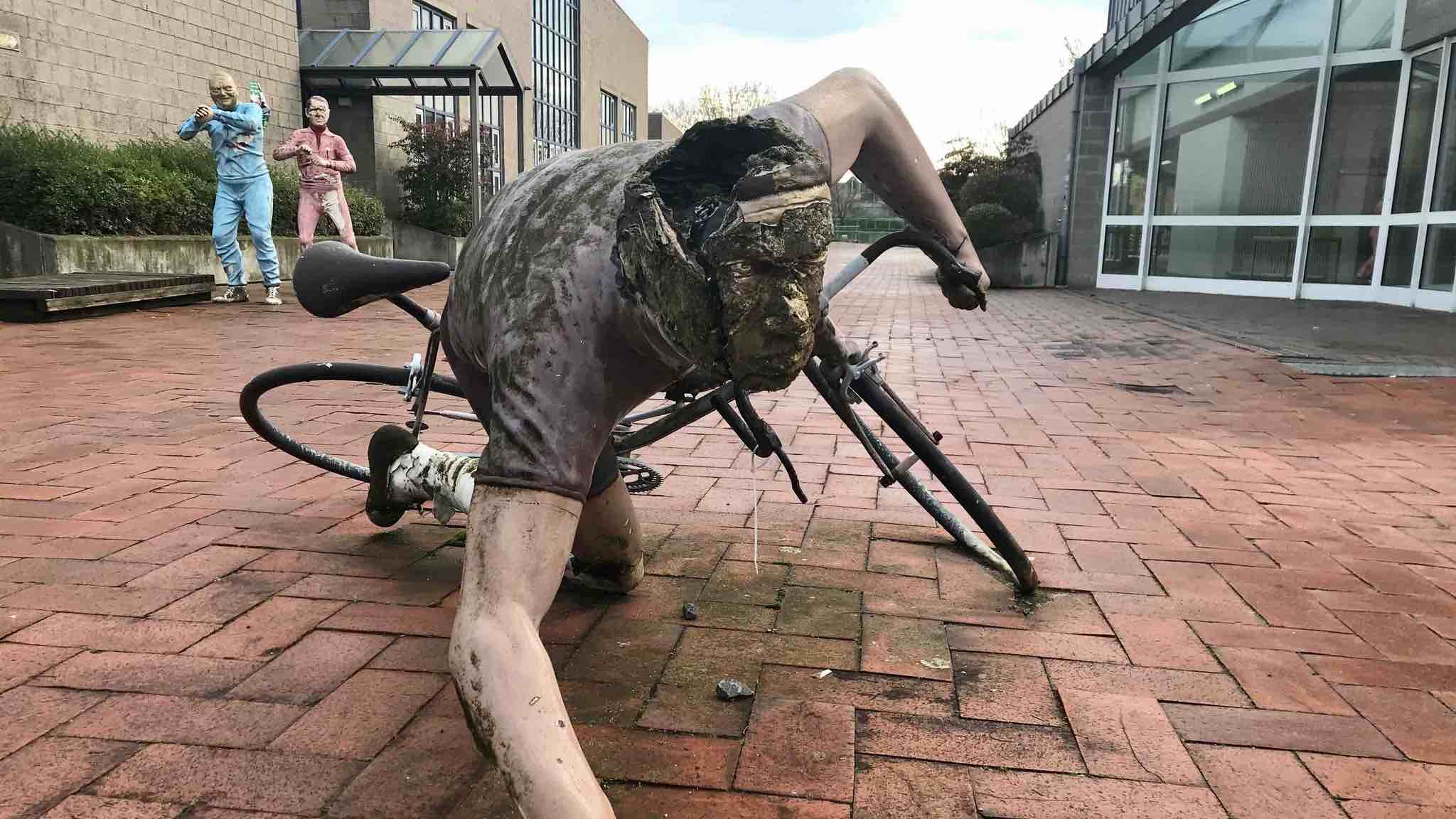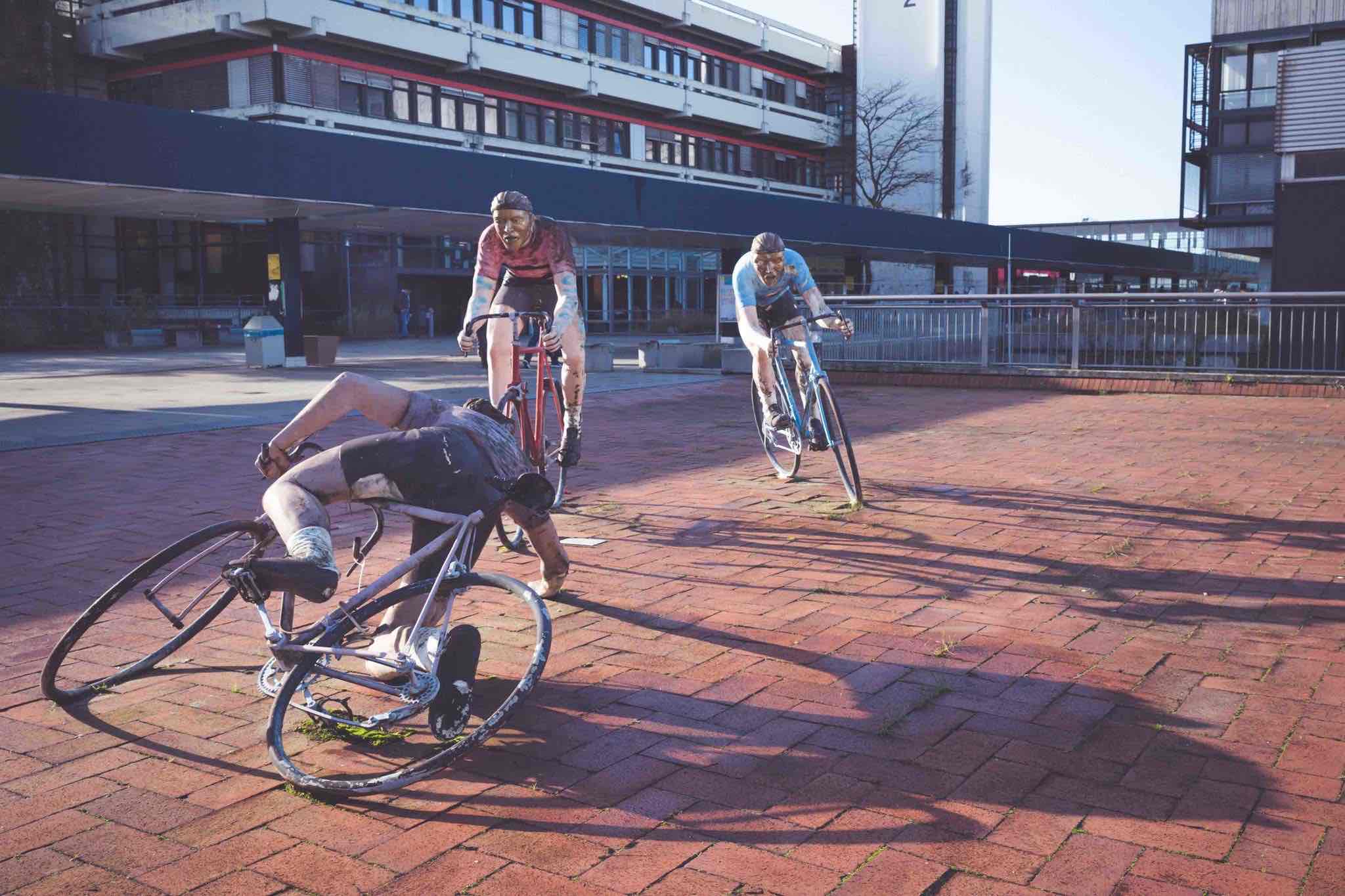
Have You Heard of… the Cyclists on the Boulevard?
There is a great deal to be discovered on campus but what is the story behind it all? up2date. has collected the answers for all of you curious readers. Welcome to your tour of the campus!
They’ve been fiercely battling to win the final since October 1978. Three cyclists whipped by their trainers. Peter Mittler, an artist from the Eifel, called the scene “Competition”. The ravages of time paired with student recklessness have taken their toll on the nearly life-size naturalistic figures. The fragments confuse many passersby yet taking a closer look is worthwhile.
The cyclist in the brown jersey has fallen badly. The cyclist in red closely following him is losing his advantage. Collision threatens. His trainer in the red training suit tells him to swerve and increase the speed. The trainer undoubtedly shares some of the characteristics of Hitler. Unthinkable chances of a win are becoming possible for the one in blue, who was originally in third position. That explains why his trainer is rubbing his hands together with pleasure.
Decay from the Beginning
The scene is impressively dramatic. It was however exposed to decay from the beginning. Maybe that has something to do with the material of choice – polyester. In 1992, restoration took place yet the cyclists appear bleak once more. Backs covered in moss or adorned with flyers, disfigured facial expressions, flaking paint.

No Decorative Art
The sculpture’s background is political. In 1973, the Bremen government signed off on the “Art in Public Spaces” program and the university wanted to profit from this in the space around the Sportturm during their second construction phase. The University Construction Office launched a national competition. A planning group that was selected especially for this purpose stated that the artistic measures were to be “more awareness-raising than compensatory”. “This awareness refers to the critical estimation of the social reality and the change of this reality in the interest of disadvantaged groups.” Thus, it was to be socially critical and not decorative. Persons interested in this topic can find bundles of files, minutes, and briefs in the university archive that throw light on the complicated process of developing the cyclists. A process that lasted from 1974 to 1978, the year of the inauguration. Consulting groups spent many meetings discussing back and forth and he artist had to repeatedly amend and change his drafts and then finally, present his work at a public colloquium.
Back to Native Basalt
For Peter Mittler, the sculptor from the 8,000 person town Mendig in the Eifel region (near to Coblenz), the socially critical sculpture made out of polyester was an exception. The enthusiastic cyclist had in fact taken over his father’s stonemasonry but rather initially made martial motorcycle sculptures out of individual parts that were welded together. He worked as a stonemason on the side and restored churches. After studying at the Cologne Art and Craft School, he tried his hand at social critical sculptures. His work gained praise at the end of the 60s and led to his rise in prominence. His group of Bremen cyclists was even exhibited at the Pompidou Center in Paris. However, Mittler quickly stepped back from the realm of political art and turned to the native basalt of the Eifel region, from which he formed sculptures. His favorite motives were dragons and mystical creatures. His last work was “Mogenia – Guardian Angel of Motorcyclists”. Peter Mittler was not able to attend the inauguration, which was attended by hundreds of bikers, as he passed away in 2004 at the age of 68. With regards to the probable durability of the group of cyclists, he wrote the following to the University Construction Office in 1976: “One must not protect a polyester sculpture against intentional destruction any more than one would a marble sculpture.” It seems that he may have been mistaken.
No Budget for Preservation
When taking the bent spokes, the grazed extremities, and the missing parts of the heads and their contents into consideration, the question of what will happen with the sculpture arises. “There is no specific budget for the preservation of works of art at the university,” explains the head of the Department for Technical Administration and Buildings, Hans-Joachim Orlok.
Based on this and the circumstance that the building preservation funds at the university are in no manner sufficient, it is necessary that priorities are set. “As an example, the repairs to roofs or the ventilation systems are of more importance,” he state. However, if the condition of the cyclists were to pose an actual threat to safety then they would need to be dismantled. The department head ends his explanation philosophically: “One can wonder whether the decay over time and the subsequent disappearance may actually be part of the piece of art”.